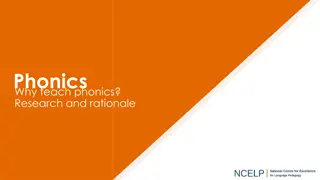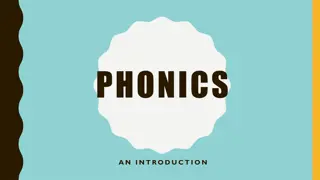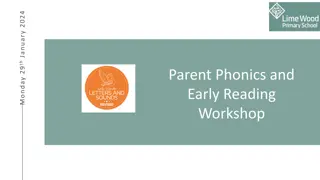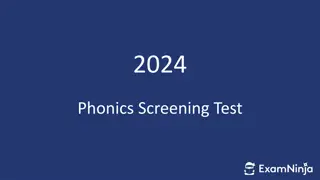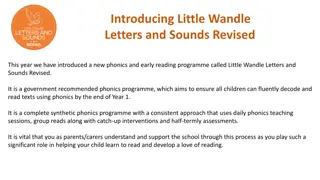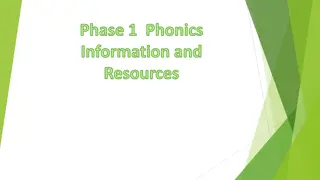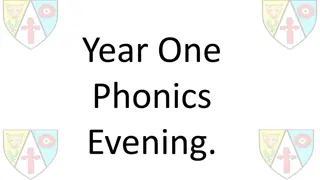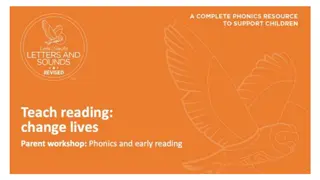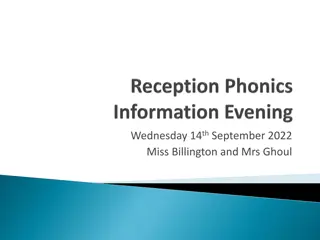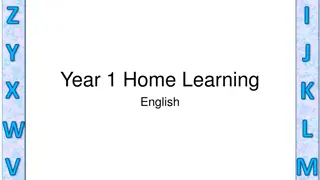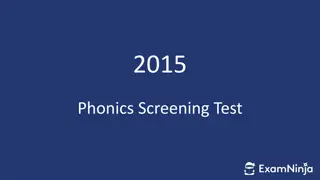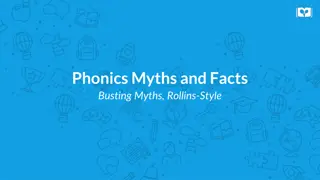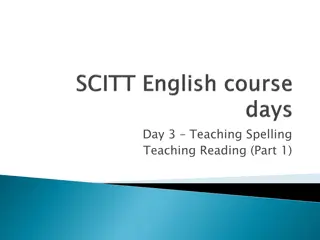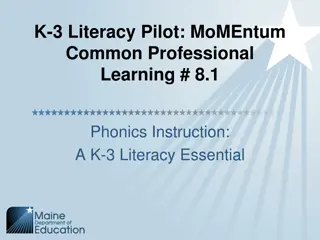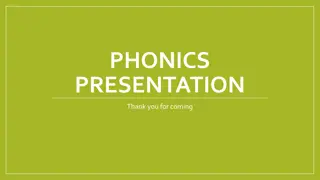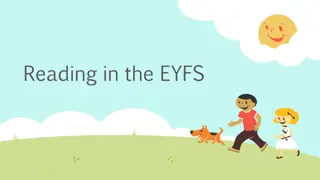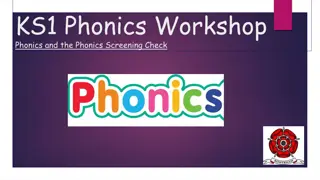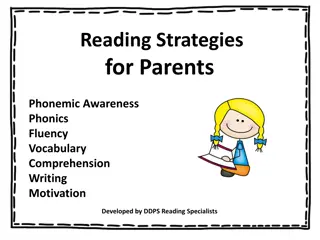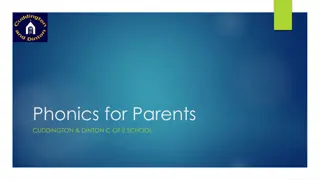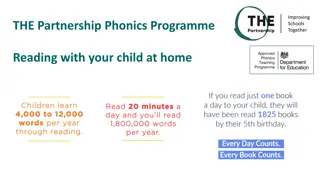Phonics and Reading Workshop at Farnborough Primary School
Explore the essence of phonics, encompassing the 44 sounds of the English language, blending skills for reading, tricky words, the Year 1 phonics screening test, and supporting reading at home. Learn the fundamentals of phonics, the alphabet, letter sounds, blending techniques, and practical exercises to enhance reading skills. Discover the significance of digraphs and practical strategies to support your child's phonics journey.
Download Presentation

Please find below an Image/Link to download the presentation.
The content on the website is provided AS IS for your information and personal use only. It may not be sold, licensed, or shared on other websites without obtaining consent from the author. Download presentation by click this link. If you encounter any issues during the download, it is possible that the publisher has removed the file from their server.
E N D
Presentation Transcript
Phonics and ReadingWorkshop Farnborough Primary School
Session Aims What does phonics mean? Understanding the 44 sounds of the English Language How to support blending skills for reading What are tricky words? The Year 1 phonics screening test Supporting reading at home
What does phonics mean? Phonics means the sounds that letters make in words There are 26 letters There are 44 sounds There are over 140 ways to combine the 26 letters to make 44 sounds We blend sounds together to help us read (build words up) We segment words into sounds to help us spell (break words down)
The Alphabet We need to learn Letter sounds (phonemes) Letter names Letter shapes A a a (graphemes) Letter pattern when writing
Letter sounds How to learn the letters and sounds of the Alphabet - YouTube How did you get on? Which sounds are most tricky? c and k make the same sound q is made of two sounds (kw) x is made of two sounds (ks) Remember to avoid making a schwa at the end of each sound; this is where it is over emphasised
Blending We blend sounds together to help us read. Blending involves saying the individual sounds in a word and running them together to make the word. For example, sounding out d-o-g and making dog. It is a technique that every child needs to learn and practice. To start with you should sound out the word and see if your child can hear it, giving the answer if needed. Some children take longer than others to hear this. The sounds must be said quickly to hear the word. It is easier if the first sound is said slightly louder
Your turn Have a go at blending some words using the sounds that we have learnt so far. Use your alphabet arc to help you. pog tabsug Slitenpod brenpigas zenlap
Blending When supporting your child with blending skills you also need to remember that some sounds are represented by two letters, such as sh. These are known as digraphs Children should sound out the digraph (sh), not the individual letters (s-h) With practice they will be able to blend the digraph as one sound in a word. A word like rain should be sounded out as r-ai-n and feet as f-ee-t. This is difficult to begin with and takes practice
Now have a go at saying these sounds. They represent the remaining sounds that make up the 44 sounds of the English language ch th th ng zh sh ai ee igh oa oo OO or ar oi air ur ear ow ure er Which is the odd one out?
Blending How would we read these nonsense words? chail pightfoy dairang chail pightfoy dairang
Blending Oneletter can represent a sound as in t a p Twoletters can represent a sound as in p i ck Threeletters can represent sound as in l ight Fourletters can represent a sound as in th r ough
Blending Use your full rainbow of sounds to have another go at blending these words. Try underlining or highlighting each word into the sounds that you can see on the rainbow. sart tighfear poajing yaireecher
How do we teach phonics in reception and Key Stage 1? Using the Letters and sounds programme Introduced in phases, grouping sounds together that can then form words e.g. satpin Using your whiteboards how many words can you make from these sounds? You have a minute to win it! at in tap sat tip nip tan pat an pan sit
How do we teach phonics in reception and Key Stage 1? The letters b and d are introduced in different groups to avoid confusion Sounds that have more than one way of being written are initially taught in one form only For example: the sound ai (rain) is taught first and the alternatives a-e (gate) and ay (day) follow later
Multi-sensory teaching Each sound is taught in a multisensory way to enable to children to recognise: Sound Letter name Shape Formation Jolly Phonics song for children in order - YouTube
Tricky words Alongside each phase of the letters and sounds programme we teach tricky words Tricky words cannot be read or spelt using our knowledge of sounds as they do not follow the rules They have to be learnt as sight vocabulary As with the 44 sounds, tricky words are also taught in phases
Tricky words the to I no go he she we me be was my you her they all are some one said come do so were when have there out like little what By the end of year one, the majority of children should be able to read and spell the above tricky words
Phonics Screening Check The phonics screening check is a short simple assessment to make sure that all pupils have learned phonic decoding (reading) to an appropriate standard by the age of 6. All year 1 pupils in maintained schools, academies and free schools must complete the check This check takes place in the Summer term
How does the check work? Your child will sit with a teacher he or she knows and be asked to read 40 words aloud Your child may have read some of the words before, while others will be completely new The check will contain a mixture of real words and non-words (or nonsense words) The check normally takes a few minutes to complete and there is no time limit. If your child is struggling your teacher will stop the check. The check is designed not to be stressful for your child (DFE 2013)
Supporting Reading Using Phonics When your child meets a word they don t know ask them to: Sound out the word from left to right try to avoid guesses based on the initial sound Concentrate on the part of the word that may not have been sounded out correctly e.g igh Tell them the correct sound that the letter/s make
Sound out the word from left to right again using the correct sounds Blend the sounds together faster and say the word In some cases you may need to tell them what the word is
Supporting Reading At Home Find a quiet place away from interruptions Sit somewhere comfortable where you can both see the book. A table is useful to prevent the book from moving around. Try to avoid the book being flat if possible. Let your child take control of the book turning pages, following the words with a finger etc. Spend a few minutes discussing the blurb and front cover before you even open the book-what do you think this book is about?
Help and support your child if they get stuck on any words. DO NOT simply tell them the words, encourage them to work it out by: -sounding out and blending -using any picture clues -using the context of the sentence to work out the word. -re-reading to check for meaning
Isolate a difficult word cover the rest of the text Break up a word into chunks (syllables) Warm the text before you start reading pick out tricky words or challenging vocabulary and help your child become familiar with the words first. Always have a whiteboard to hand or try using magnetic letters
When your child is reading more independently use the 3Ps Pause (before you tell them the word) Prompt (if they needs a little help) Praise
Ask your child questions to check their understanding of the text e.g. What was your favourite part? How did you feel about the main character? Which words show you that the character is happy? What might happen next? Don t forget that they can ask the questions too!
Give your child lots of praise and encouragement Do not worry if your child does not remember a word that they have read easily before. Stay positive and simply encourage and help them work it out again
Try not to read with your child whilst you are helping their siblings or completing other tasks
Dont make your child read there and then if they are really not in the mood. Suggest another time and walk away Have fun reading together
Fiction Books Fact Books Comics Newspapers Instructions Recipes Shopping lists Labels Advertisements Signs Road Names
Even when your child becomes an independent reader sharing bedtime stories will enable your child to enjoy literature, extending their vocabulary and comprehension of stories. The more stories and books your child hears, the more they will want to read Often shared stories are memories that children carry with them for life
F.A.Qs. 1. Are there any other reading strategies that my child can use as well as phonics? The current government guidance places the emphasis on phonics. However, at Farnborough we are aware that children s learning styles vary. Other strategies that we use include learning and recalling whole words and gaining a good understanding of word families and rhyming skills (light, fight, might). We also look at words in context, prediction skills and reading around the word etc. 2. How often does my child read to an adult at school? Children in Reception, Year 1 and Year 2 are heard at least once a week. This is sometimes as part of a small guided reading group and sometimes as individuals. 3. Who listens to them read in class? The class teacher, teaching assistants or a trained volunteer. The children are rotated in order to ensure that they are heard by their class teacher on a regular basis.
4. How many books are provided by the school? The children receive three books a week, one printed book and two from the Bug Club reading scheme which is computer based. They also have the chance to choose a book from the school library on a weekly basis. Additionally, we encourage parents to visit the local libraries with their children. As well as decoding the words, it is vital that the children understand what they are reading. To encourage this, we suggest that you talk about the book with your child and ask questions to secure their understanding. Shared reading together is a great way of reading a book, as well as children reading by themselves. 5. What books are involved in the reading scheme? The core books are part of the Oxford Reading Tree and the Bug Club scheme. The Bug Club includes some Oxford Tree books. 6. What happens when my child completes the last stage of the reading scheme? Your child will become known as a free reader and will have the opportunity to choose their own books. They will be encouraged to continue to choose books available at school as well as those they have at home.
7. How long should I read with my child and how often? Every day would be great in an ideal world; each session on average lasting between 10 and 20 minutes. 8. Does my child have to read the whole book in one sitting? Your child should not feel pressured to read a story from beginning to end. You may cover a couple of pages in detail. You may have discussed the title and what is happening in the pictures. You may have used some time to predict what happens next.
9. My child is a reluctant reader. What can I do to motivate them and make reading enjoyable? Be a good role model read regularly with your child and be seen as a reader yourself. Team reading take it in turns to read, reading in unison, echo reading, parent reading to child, be the teacher. Playing games within the books who can find the word was , how many sh sounds can you spot? Can you find a word that rhymes with cat ? Can you find another word that starts with the j ?
Offering alternative books/reading materials that engage your child s interest e.g. trains, princesses, pirates, dragons, fairies, fun information etc. Please ensure that you avoid referring to the school books as homework and the other books as fun . PRAISE PRAISE PRAISE! Reading is a crucial skill in life. Let s make it as enjoyable as we can in any way that works for you and your family.
The five finger rule Is your child s book too difficult to read? How can you tell? Use the five finger rule. Get children to read one page from the book. For each word they cannot read get them to hold up a finger. If they hold up five fingers before the end of the page then the book is more than likely to be too challenging Showing the children how to do this will help themselves when choosing a book


